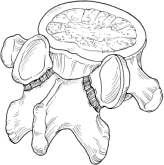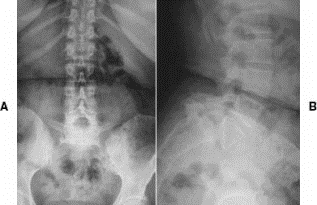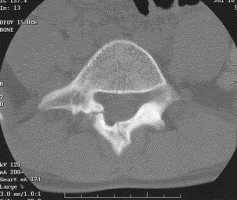Definition: the slipping forward of one vertebra upon another. Incidence is approximately 6% of population. Common in gymnasts, football players, weightlifters.
Spondylolysis is the presence of a bony defect at the pars interarticularis, the space between the superior and inferior facet, and can lead to spondylolysthesis
Etiology (Wiltse classification):
- Type I = dysplastic deficiency of superior sacral facet, inferior 5th lumbar facet, or both
- Type II = isthmic type, defect in pars interarticularis (types I & II most common)
- Type III = degenerative form, mostly L4-5
- Type IV = traumatic form
- Type V = pathologic form, caused by neoplasm
Signs/Symptoms:
- May be asymptomatic
- Back pain
- Leg pain
- Radicular pain, bowel or bladder symptoms rare
- Isthmic spondylolisthesis commonly presents between 10-15 years
- Extent of slippage may not correlate with pain
- L5 slippage on sacrum is most common
Radiographs:
- Lateral view shows defect
- Oblique view demonstrates “Scottie dog” with “collar” or “broken neck” sign indicating pars defect

Classification:
- Slip angle = measure of lumbosacral kyphosis, helps determine likelihood and presence of progression on younger patients
- Meyerding’s classification
- Grade I = 1-25% slippage
- Grade II = 26-50% slippage
- Grade III = 51-75% slippage
- Grade IV = 76-100% slippage
Treatment:
- Grades I and II managed conservatively by restricting aggravating activities, bracing to reduce lumbar lordosis, physical therapy
- Grade III & IV slips are at risk for progression, especially in skeletally immature patients, and fusion is recommended
- Fusion indications are: demonstrate progression of slip, greater than 50% slip, fail to respond to conservative measure, and skeletal immaturity
- Combined spinal decompression and fusion are indicated if neurological findings present (numbness, weakness, bowel or bladder compromise
- Pars repair possible in young patients with minimal slip



